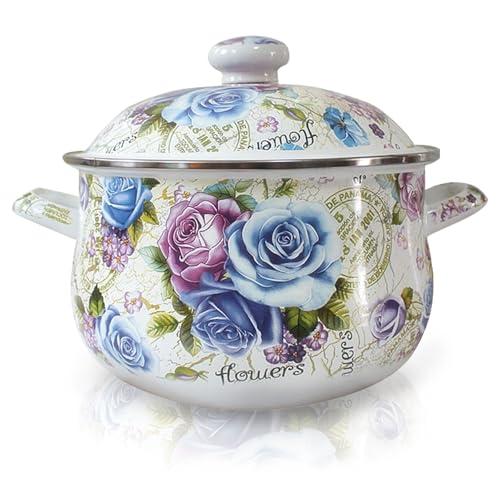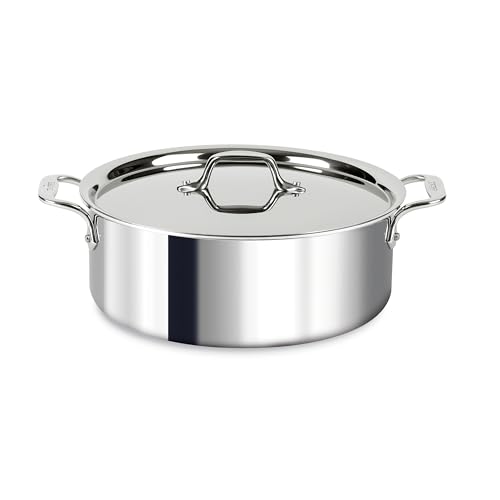There’s a particular kind of culinary heartbreak that I remember all too well. I’d spent hours crafting a rich, complex beef stew. The aroma filled the house, a promise of a perfect, comforting meal. But when I went to stir it one last time, I felt it—that dreaded scraping sensation. The bottom of my cheap, thin-walled stockpot had betrayed me, creating a scorched, bitter layer that tainted the entire batch. It was a lesson learned the hard way: a great stockpot isn’t just a large container; it’s the foundation of countless meals, from simmering bone broths and hearty chilis to boiling pasta for a family gathering. A poor one creates hot spots, burns your food, and makes cleanup a nightmare. A quality stockpot, however, provides consistent, even heat, turning a potentially stressful cooking process into a joyful, reliable experience.
- EVEN, CONSISTENT HEAT: Thick, forged base is designed to heat evenly for experimenting with new recipes and getting rich, flavorful...
- DURABLE CONSTRUCTION: Crafted from durable hard anodized aluminum, this premium-quality pot is built for everyday inventive cooking
What to Consider Before You Invest in a New Stockpot
A stockpot is more than just an item; it’s a key solution for any home cook who loves making large-batch meals. Whether you’re simmering a week’s worth of soup, preparing a huge portion of bolognese sauce for the freezer, or simply boiling potatoes for a holiday feast, this is the go-to piece of cookware. Its high sides and large capacity are specifically designed to reduce evaporation during long simmers and prevent boil-overs, ensuring your stocks and sauces develop deep, rich flavors. The primary benefit is its sheer volume and versatility, allowing you to cook for a crowd or meal prep with unparalleled ease.
The ideal customer for this type of product is someone who frequently cooks in large quantities. This includes families, avid meal-preppers, and anyone who enjoys hosting dinner parties. If you find yourself consistently running out of space in your largest saucepan, a dedicated 8-quart stockpot will be a game-changer. Conversely, it might not be suitable for those who live in a small apartment with minimal storage space or who typically only cook for one or two people. For them, a smaller 4 or 5-quart Dutch oven might be a more practical and space-efficient alternative.
Before investing, consider these crucial points in detail:
- Dimensions & Space: An 8-quart pot is substantial. Before you buy, check its diameter (this one is about 10 inches at the top) to ensure it fits comfortably on your largest burner without crowding out other pans. Also, consider your cabinet or pantry space; you’ll need a tall, wide spot to store it, especially with the lid.
- Capacity/Performance: Eight quarts is a fantastic, versatile size, perfect for a whole chicken, a large batch of chili, or several pounds of pasta. Performance-wise, the key is heat distribution. A thick, heavy base is non-negotiable for preventing the scorching I experienced. Look for pots specifically designed to eliminate hot spots for consistent results.
- Materials & Durability: Hard-anodized aluminum, like that used in the KitchenAid 8 Quart Stock Pot, offers excellent heat conductivity and is more durable than standard aluminum. Stainless steel is a workhorse known for its longevity and high-heat searing capabilities but lacks nonstick properties. Nonstick coatings offer incredible convenience but raise questions about long-term durability and safety if they begin to degrade.
- Ease of Use & Maintenance: Consider the weight and the comfort of the handles, especially when you’ll be lifting a pot full of hot liquid. Features like a nonstick interior and dishwasher-safe claims simplify cleanup, but it’s crucial to investigate if these features hold up over time. Long-term care often involves avoiding metal utensils and high heat to preserve the cooking surface.
While the KitchenAid 8 Quart Stock Pot is an excellent choice, it’s always wise to see how it stacks up against the competition. For a broader look at all the top models, we highly recommend checking out our complete, in-depth guide:
- Stainless steel and 5 layers bottom: Kirecoo 8-Quart Stainless Steel Stockpot with Lid is an essential kitchen cookware, boasting an...
- Large capacity: holds up to 8 quarts--great for large batches of soups, stews, and more
- Uniform heat dissipation:Perfect for Electric stove/Halogen stove/Induction cooktop/Gas stove. Warm Tip: The enamel products may...
Unboxing the KitchenAid: First Impressions and Key Features
Upon opening the box, the KitchenAid 8 Quart Stock Pot immediately presents itself as a serious piece of cookware. The matte black finish is sleek and modern, giving it a professional look that feels at home in any kitchen. Lifting it from the packaging, the first thing we noticed was its reassuring heft. It’s constructed from heavy-gauge, hard-anodized aluminum, and you can feel the quality in its weight—it’s substantial without being excessively heavy, a sentiment echoed by users who noted it “no pesan tanto” (they don’t weigh much). The pot feels balanced and sturdy.
The interior boasts a triple-layer, PFOA-free nonstick coating that appears smooth and durable. A premium touch is the extension of this coating over the handle rivets, a detail often overlooked in lesser pans, promising a truly easy-release surface. The handles themselves are stainless steel, solidly riveted to the pot, and designed for a comfortable grip. The included tempered glass lid fits snugly, allowing you to monitor your cooking without losing heat and moisture. At first glance, this pot looks and feels like it’s built for inventive, everyday cooking, just as KitchenAid claims. You can see its full feature set and user reviews to get a better sense of its initial appeal.
What We Like
- Excellent, even heat distribution from the thick, forged base.
- Initially superb triple-layer nonstick performance, including on rivets.
- Sturdy yet manageable weight and comfortable handles.
- Versatile performance, oven-safe up to 500°F (without lid).
What We Didn’t Like
- Widespread reports of the nonstick coating peeling and flaking over time, especially at the rivets.
- The base’s raised metal rings may scratch sensitive glass or induction cooktops.
Performance in the Kitchen: A Deep Dive into the KitchenAid Stock Pot
A pot can look great on the counter, but its true value is only revealed on the stovetop. We put the KitchenAid 8 Quart Stock Pot through a series of tests, from simmering delicate sauces to slow-cooking a massive batch of chili, to see if its performance matched its promising first impression. We focused on three core areas: heat distribution and consistency, the performance and longevity of its nonstick surface, and its overall design and usability during daily cooking and cleanup.
Heating Performance: Even and Consistent, with an Induction Caveat
The single most important job of a stockpot is to heat its contents evenly, and here, the KitchenAid excels. The brand touts its “thick, forged base,” and our testing confirms this isn’t just marketing speak. We started by sautéing a large mirepoix (diced onions, carrots, and celery) for a soup base. On lesser pots, the center often gets too hot while the edges lag, leading to uneven cooking. With this pot, the vegetables softened and browned at a remarkably consistent rate across the entire 7.25-inch flat bottom. There were no hot spots, no scorching, and no constant need to chase ingredients around the pan.
This experience is backed by meticulous user testing. One owner measured the temperature across the pot’s surface over three minutes, finding a variation of only 2°F between the center and the middle, and a gradual, expected drop-off toward the side walls. This is the kind of performance that gives you confidence, whether you’re browning meat for a stew or carefully reducing a sauce. On our induction cooktop, the raised rings on the base, which one user praised as a “great design for better heat induction,” engaged the burner instantly and delivered responsive power. However, this design feature comes with a serious warning. Another user reported that these same metal rings “will absolutely scratch the glass” of their induction range. We tested this with care and, while we didn’t cause deep gouges, we could see how aggressive stirring or sliding the pot could easily mar a delicate glass surface. It’s a design choice that boosts performance for some but introduces a significant risk for others, a trade-off potential buyers must seriously consider.
The Triple-Layer Nonstick Surface: A Double-Edged Sword
In its prime, the nonstick surface on the KitchenAid 8 Quart Stock Pot is nothing short of spectacular. For our chili test, we seared ground beef and then let the chili simmer for over three hours. The rich, dark sauce bubbled away without a hint of sticking. When it was time to serve, the chili poured out cleanly, leaving behind minimal residue. Cleanup was effortless; a simple wipe with a soapy sponge was all it took. The fact that even the handle rivets are coated is a feature that really sets it apart in initial quality, preventing those annoying crusty rings of food that form around uncoated hardware. For the first few months of use, this pot is a dream.
Unfortunately, this is where our glowing report hits a significant roadblock, one that is echoed in an alarming number of user experiences. The long-term durability of this nonstick coating is highly questionable. We found numerous, consistent reports from users who, despite following care instructions religiously—hand washing only, never using metal utensils, avoiding high heat—saw the coating begin to fail. The most common point of failure is precisely where KitchenAid tried to add a premium feature: the rivets. Report after report, some with photographic evidence, shows the nonstick coating bubbling, peeling, and flaking off from the rivets holding the handle. One user noted the coating came off after “less than 10 times” of use. Another, who used their set several times a week, saw the coating start to wear after a year and begin “flaking off” after two. When the nonstick surface fails, the pot is no longer safe to use, as no one wants those flakes in their food. This transforms the pot from a long-term kitchen investment into a disposable item with a surprisingly short lifespan.
Design, Usability, and Cleanup
Beyond its core cooking functions, the KitchenAid 8 Quart Stock Pot is thoughtfully designed for everyday use. At 2.84 kg (just over 6 pounds), it’s heavy enough to feel stable and durable on the stovetop but not so heavy that it becomes unwieldy to move from the stove to the sink, even when partially full. The stainless steel handles are well-shaped, providing a secure and comfortable grip for lifting. During our testing, they remained cool enough to touch on the stovetop, though you’ll always need oven mitts when taking it out of the oven.
The pot’s versatility is a major plus, with an impressive oven-safe temperature of 500°F. This allows you to start a dish on the stove and finish it in the oven, perfect for braising meats. The tempered glass lid, oven-safe to a lower 350°F, fits well and is convenient for monitoring cooking progress. However, as one user pointed out, the lid lacks a vent hole, which can cause rattling and pressure buildup during a vigorous boil. We also have to mention the rare but serious incident reported by one owner whose lid “suddenly shattered” during cooking, a frightening possibility. On the topic of cleanup, there’s confusion. The product description clearly states it is “dishwasher safe for convenient and easy cleanup.” Yet, one user discovered conflicting instructions on the packaging wrapper, and their attempts to get clarification from the manufacturer were frustrating and unsuccessful. Given the widespread issues with the nonstick coating’s durability, our expert recommendation is to ignore the “dishwasher safe” claim entirely. Gentle hand washing is the only way to potentially prolong the life of this pot, although evidence suggests even that may not be enough.
What Other Users Are Saying
The sentiment surrounding the KitchenAid 8 Quart Stock Pot is sharply divided, following a clear pattern: initial delight followed by long-term disappointment. Many users begin their journey full of praise. One reviewer stated, “They are very good, high quality and not too heavy. You don’t need to add oil to prevent food from sticking.” Another was impressed by its heating, noting its nonstick properties were on par with a much more expensive Eurocast pan.
However, this initial satisfaction is consistently overshadowed by a critical flaw. The most frequent and serious complaint revolves around the nonstick coating’s lack of durability. A user who owned the pot for just 14 months, never used metal utensils, and used it daily, reported it was already “peeling and pitted.” This experience is not isolated. Another frustrated owner who babied their set—always hand washed, never on high heat—noted, “After 2 years it’s now starting to flake off.” The failure point is almost universally identified around the handle rivets. This issue is so prevalent that it becomes the defining characteristic of long-term ownership, leading many to conclude, “We’re done with non stick.” While less common, other issues like the base scratching glass cooktops and poor customer service response from the manufacturer further tarnish the user experience.
How Does It Compare? KitchenAid vs. The Competition
The KitchenAid 8 Quart Stock Pot exists in a competitive market. To understand its true value, it’s essential to compare it against some popular alternatives that cater to different needs and budgets.
1. Granitestone True 20 Pc Nonstick Cookware Set
- Complete Kitchen in a Box: This kitchen cookware set includes everything you need to start cooking and baking like a pro right out of...
- Long Lasting Nonstick: Think healthier foods, easy food release, and an effortless cleanup for years to come with Granitestone- Each...
If your primary concern is value and outfitting an entire kitchen at once, the Granitestone set is a compelling option. For a price often comparable to a single premium stockpot, you get a complete 20-piece collection, including various pots, pans, and even bakeware. Its appeal lies in its sheer volume and entry-level accessibility. However, it’s a quantity-over-quality proposition. While it provides a nonstick surface, it’s unlikely any single piece will match the KitchenAid’s initial robust build and superior heat distribution. This set is perfect for a first apartment, a college student, or someone who cooks infrequently and needs a bit of everything without a major investment. It’s not for the discerning home cook seeking a specialized, high-performance stockpot.
2. All-Clad D3 6-Quart Stockpot
- 3-Ply bonded construction
- Dishwasher-safe; Hand-washing recommended
The All-Clad D3 represents the opposite end of the spectrum from nonstick convenience. This is a “buy it for life” piece of cookware. Made in the USA from 3-ply bonded stainless steel, its heat control, durability, and performance are legendary in the culinary world. It can handle incredibly high heat, is perfect for searing, and will likely outlive its owner. The trade-off is the absence of a nonstick coating, which requires more oil and different cooking techniques to prevent sticking. It’s also a smaller 6-quart capacity and carries a significantly higher price tag. This pot is the choice for serious home cooks and aspiring chefs who prioritize longevity and raw performance above all else and are willing to invest in heirloom-quality tools.
3. HexClad 8-Quart Hybrid Stockpot
- HexClad’s Hybrid technology features a laser-etched hexagonal nonstick surface that combines both stainless-steel and our TerraBond...
- Our Hybrid 8-Quart Stock Pot is your go-to when you're making bigger batches of soups, stews, pasta and sauces for a crowd or enough...
HexClad attempts to bridge the gap between stainless steel and nonstick with its innovative hybrid technology. A laser-etched stainless steel lattice stands proud of a PFOA-free nonstick surface. This design aims to provide the searing power and durability of steel while still offering easy food release and cleanup. It boasts an incredibly high oven-safe temperature (900°F), stay-cool handles, and is backed by a lifetime warranty, addressing the primary durability concerns of traditional nonstick like the KitchenAid. The main drawback is its premium price point, placing it in a much higher budget category. The HexClad is for the modern cook who wants cutting-edge technology, is tired of replacing peeling nonstick pans, and is willing to pay a premium for performance and peace of mind.
Our Final Verdict: Is the KitchenAid 8 Quart Stock Pot Right for You?
The KitchenAid 8 Quart Stock Pot is a product of two conflicting truths. On one hand, its initial performance is excellent. It’s a beautifully designed pot with a substantial feel, it heats remarkably evenly, and its nonstick surface makes both cooking and cleaning an absolute pleasure. For short-term use, it delivers on its promises, providing a fantastic user experience for making soups, stews, and large-batch meals. On the other hand, the overwhelming and consistent user feedback regarding the premature failure of its nonstick coating is a fatal flaw that cannot be overlooked. The pattern of peeling and flaking, particularly around the handle rivets, suggests a significant durability issue that undermines its long-term value.
Because of this critical issue, we can only recommend this pot with strong reservations. If you are a casual cook who needs a large, affordable stockpot for occasional use and you accept that it may only last for a year or two, it could be a decent choice. However, for anyone seeking a durable, reliable piece of cookware to be a workhorse in their kitchen for years to come, we strongly advise looking elsewhere. The frustration of having to replace your pot so soon outweighs its initial benefits. Instead, investing in a robust stainless steel option like the All-Clad or a high-tech hybrid like the HexClad would be a far wiser long-term decision. If you understand the potential lifespan and are still intrigued by its short-term performance, you can check the latest price and availability online.
Last update on 2025-11-16 / Affiliate links / Images from Amazon Product Advertising API







